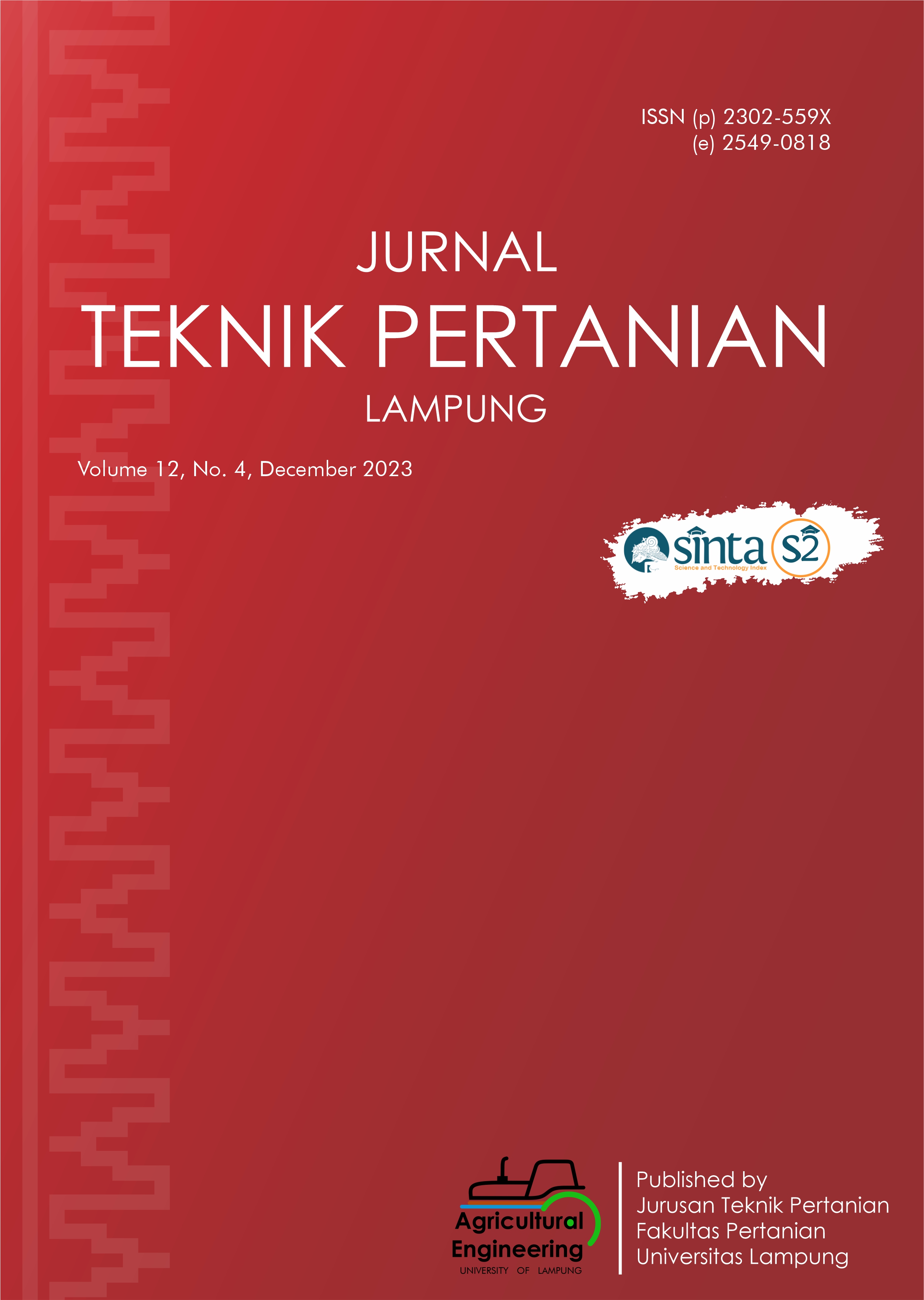Study of Coffee Bean Displacement Inside Drum Roaster Using Force Balance Analysis
DOI:
https://doi.org/10.23960/jtep-l.v12i4.909-920Abstract
The drum roaster's design and operating method significantly affect the coffee roasting process. The coffee bean displacement inside the drum roaster can be observed to compare the drum roaster's different designs and operating methods. The coffee bean movement is crucial since it affects the heat transfer distribution among coffee beans inside the drum roaster. The more dynamic displacement of coffee beans gives more even heat distribution. Force balance analysis can be used to predict the coffee bean displacement since it can predict particle movement with mutable variables. This paper compares the coffee bean displacement inside the drum roaster with flippers and without flippers using simple force balance analysis. The analysis involves tangential force, centrifugal force, frictional force, and the beans' weight itself. The analysis shows that the radius of the drum roaster (r) and angular acceleration () significantly change the resultant force's dynamic, and the various tilt angle of flippers (2) did not too significantly affect it. The bigger radius (r) and angular acceleration () generate a stronger centrifugal force influencing the bean's equilibrium. The direction change of force resultant applied to the bean is more smooth in the drum with flippers than without flippers.
Keywords: Coffee bean displacement, Drum coffee roaster, Force balance analysis, Resultant force Turning point duration
References
Al-Shemmeri, M., Windows-Yule, K., Lopez-Quiroga, E., & Fryer, P.J. (2023). Coffee bean particle motion in a rotating drum measured using Positron Emission Particle Tracking (PEPT). Food Research International, 163, 112253. https://doi.org/10.1016/J.FOODRES.2022.112253
Aussems, D.U.B., Khrapak, S.A., Doǧan, I., Van De Sanden, M.C.M., & Morgan, T.W. (2017). An analytical force balance model for dust particles with size up to several Debye lengths. Physics of Plasmas, 24(11). https://doi.org/10.1063/1.5001576
Chen, Y., Li, G.Q., & Hu, Y.Q. (2006). Force balance analysis of a coronal magnetic flux rope in equilibrium or eruption. The Astrophysical Journal, 649.
Cristo, H.P., Martins, M.A., Oliveira, L.S., & Franca, A.S. (2006). Transverse flow of coffee beans in rotating roasters. Journal of Food Engineering, 75(1), 142–148. https://doi.org/10.1016/J.JFOODENG.2005.04.010
Daywin, F.J., Gozali, L., Widodo, L., Doaly, C.O., & Ross, M.W.H. (2020). Community Service Report: Designing The Ergonomic Roasting Machine For Coffee Seed With Additional Electrical Motor At Seduh Kopi Coffee Shop. IOP Conference Series: Materials Science and Engineering, 852, 012091. https://doi.org/10.1088/1757-899X/852/1/012091
Dwiartomo, B., Andriyanto, Y., Purnomo, W., Ruswandi, A. (2022). Perancangan Blade dan Pengembangan Prototipe Tangensial Drum Mesin Roasting Kopi. Jurnal Rekayasa Mesin, 17(1), 1–14. https://doi.org/10.32497/JRM.V17I1.2798
Faris, N., Zeru, B. A., & Tadese, E. (2019). Design and modelling of drum type coffee roasting machine using liquefied petroleum gas (LPG) as a source of energy. [JIMMA INSTITUTE OF TECHNOLOGY]. https://repository.ju.edu.et//handle/123456789/5593
Hidayat, D.D., Sudaryanto, A., Kurniawan, Y.R., Indriati, A., & Sagita, D. (2020). Development and evaluation of drum coffee roasting machine for small-scale enterprises. INMATEH - Agricultural Engineering, 60(1), 79–88. https://doi.org/10.35633/INMATEH-60-09
Huschke, R. (2007). Industrial Cofee refinement. Verlag Moderne Industrie.
Hussein, T.F., Ichwana, I., & Syafriandi, S. (2022). Modifikasi sirip pengaduk pada mesin penyangrai kopi tipe tabung menggunakan sumber panas listrik. Jurnal Ilmiah Mahasiswa Pertanian, 7(4), 977–984. https://doi.org/10.17969/JIMFP.V7I4.22325
Krishna, P.S., Pradeep, P., Bivek, B., & Bim, P.S. (2017). Mathematical modeling, simulation and analysis of rice grain movement for design and fabrication of low-cost winnowing machine. Journal of Mechanical Engineering Research, 9(1), 1–14. https://doi.org/10.5897/JMER2016.0403
Li, Y., & Gurnis, M. (2022). A simple force balance model of subduction initiation. Geophysical Journal International, 232(1), 128–146. https://doi.org/10.1093/GJI/GGAC332
Lubis, A., Syafriandi, S., Idkham, M., & Maulana, A. (2023). Design and construction of coffee roasting machine with rounding cylinder tube using electric heat source. Research in Agricultural Engineering, 69(3), 118–123. https://doi.org/10.17221/69/2022-RAE
Ogunjirin, O.A., Odeniyi, O.M., Olubo, A.S., Farounbi, A.J., Ola, O.A., & Adeleke, S.A. (2020). Design and construction of an electrically powered coffee roasting machine. IOP Conference Series: Earth and Environmental Science, 445, 012009. https://doi.org/10.1088/1755-1315/445/1/012009
Pavoni, M. (2021). Coffee roasting basics: Conduction vs. convection. MTPAK Coffee Ltd. https://mtpak.coffee/2021/12/coffee-roasting-conduction-vs-convection/
Rao, S. (2014). The Coffee Roaster’s Companion by Scott Rao (first edition). https://www.scottrao.com/
Schmidt, K. (2012, January 17). Spotlight on Drum Roasting : Drumming Up Slow, Dark Roasts. https://m.blog.naver.com/xin999/150129404265 (Accessed 26 Oct 2023)
Sofii, I. (2014). Rancang bangun mesin penyangrai kopi dengan pengaduk berputar. Jurnal Ilmiah Teknik Pertanian - TekTan, 6(1), 34–45. https://doi.org/10.25181/TEKTAN.V6I1.857
Suryadi, D., Ramadhani, S., Suandi, A., Suparrdi, N.I., & Daratha, N. (2023). Design and manufacture of portable coffee roaster with LPG heater system. Jurnal Polimesin, 21(1), 122–126. https://doi.org/10.30811/JPL.V21I1.2622
Sutarsi, S., Soekarno, S., & Widyotomo, S. (2010). Performance evaluation of rotating cylinder type coffee bean roaster. Jurnal Keteknikan Pertanian, 24(1), 33-38.
Yuwana, Y., Evanila, S., & Bosman, S. (2014). Hubungan antara berat dengan sifat fisiko-mekanik kopi beras dari buah dengan tingkat kematangan panen berbeda. Jurnal Agroindustri, 4(1), 21-30
Downloads
Published
Issue
Section
License
- Authors who publish with this journal agree to the following terms:
- Authors retain copyright and grant the journal right of first publication with the work simultaneously licensed under a Creative Commons Attribution-ShareAlike 4.0 International Lice that allows others to share the work with an acknowledgement of the work's authorship and initial publication in this journal.
- Authors are able to enter into separate, additional contractual arrangements for the non-exclusive distribution of the journal's published version of the work (e.g., post it to an institutional repository or publish it in a book), with an acknowledgement of its initial publication in this journal.
- Authors are permitted and encouraged to post their work online (e.g., in institutional repositories or on their website) prior to and during the submission process, as it can lead to productive exchanges, as well as earlier and greater citation of published work (See The Effect of Open Access).
Jurnal Teknik Pertanian Lampung

JTEPL is licensed under a Creative Commons Attribution-ShareAlike 4.0 International License.

